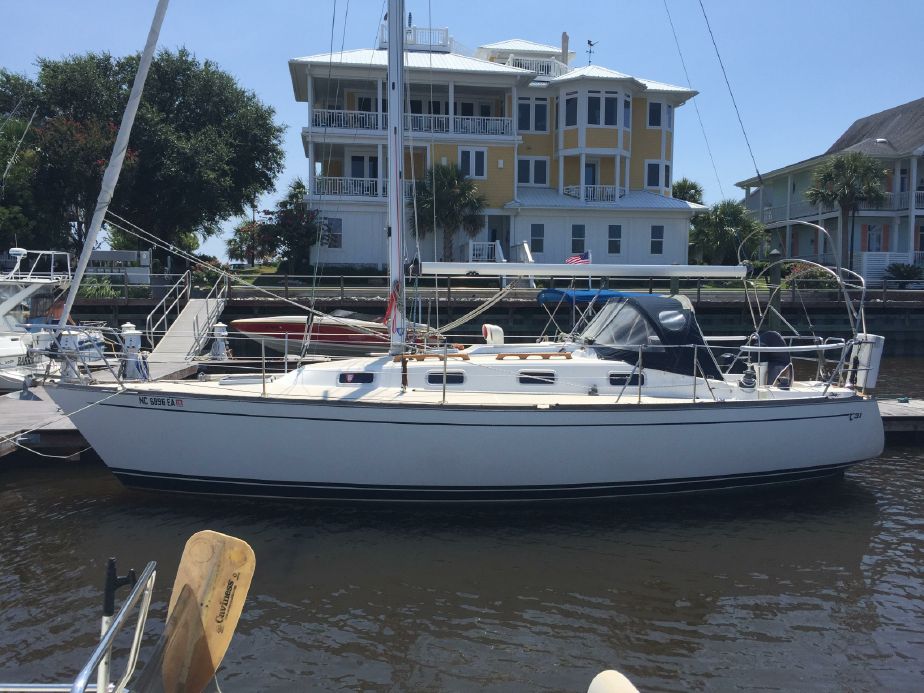Since its genesis 50 years ago as Douglass McLeod Plastics, Tartan Marine has literally risen from the ashes of a plant fire, as well as survived financial hard times, and remains one of the most recognizable and respected boat builders among sailors worldwide. One of my favorite Tartan models of the late 1980s and early 1990s, the Tartan 31, is a sensible design that has proven her versatility as a mid-sized daysailer, club racer, and coastal cruiser for more than 20 years.
Design credit goes to Tartan’s design team headed by company president and chief designer Tim Jackett. The design is what I would describe as a conservative/contemporary cruiser measuring 31’ 4” length overall with a 10’ 11” beam. There are nicely balanced overhangs at the bow and stern resulting in a waterline length of 26 feet, and the designed displacement is a bit over 9000 pounds. With the standard elliptical fin keel, draft is six feet, and shoal draft versions drew 4’ 4”.
The Tartan 31 was introduced in late 1987, and approximately 150 boats were built between then and 1991. After emerging from bankruptcy in 1992, a restyled 31 was introduced as the Tartan 31 Piper, later to become the Tartan 3100, which continued in the company’s line until 1999. From a practical standpoint, the models can be considered the same. The most recognizable differences are the inclusion of a molded swim step in the transom of the restyled version and a change from a Scheel-designed “flared tip/cord” to a Jackett-designed “beaver tail” keel on shoal-draft models.
Tartan’s target customer seems to have always been Tartan owners moving up or down and first-time buyers willing to pay extra for higher quality fit, finish, and craftsmanship than typically offered by more cost-driven production builders. The hull is built with hand-laminated alternating layers of fiberglass mat, unidirectional fiberglass cloth, and polyester resin. Vinylester resin is used for the outer laminate to mitigate osmotic blistering below the waterline. Decks are sandwich-constructed with fiberglass cloth, polyester resin, and balsa wood core, and the deck-hull joint is made on an inward flange with mechanical fasteners and flexible adhesives. The quality of construction is above average. The use of both fiberglass liners and wood joiner work for interior components allows better access for service, installation, and repair than boats that rely on single-piece fiberglass interior liners.
Perhaps the most notable feature of the deck arrangement is the size of the teak toe rail— actually large enough to provide a suitable foothold. Rigging shrouds and genoa track are inboard against the cabin house allowing for close sheeting angles and ease of passage. The T-shaped cockpit provides comfortable seating for four adults although the mainsheet is on the cabin top, at the companionway, and is out of reach of the helmsman.
Traditionalists are probably not going to like the cacophony of angled bulkheads and joiner work below on the Tartan 31. Designers generally do this to create more space in a given area such as the main saloon. However, angling bulkheads to gain space on one side can’t help but reduce it on the other. Angling the bulkheads on the Tartan 31 reduces the usefulness of the settees as comfortable berths and makes for a very small head. That said, the interior looks great with lots of quality teak and teak-veneered joiner work. There is decent storage, a nice galley to starboard, and a comfortable master stateroom forward.
Most Tartan 31 models were powered by two-cylinder, 18-horsepower Yanmar diesels; although later 3100 models were powered by similarly sized Westerbeke engines. Both are dependable marine engines supported by a good network of service centers. Eighteen horsepower is adequate for this 9000-pound boat. The engine is located in an engine box beneath the companionway steps, and accessibility for service is as good as can be found on sailboats of any size. Do-it-yourselfers and service mechanics alike will love this arrangement.
The sail plan of the Tartan 31 is conservative by today’s standards with a sail area/displacement ratio of 18.67. This seems to be a nice balance that should keep club racers happy, yet not scare the bajesus out of cruising sailors. Most owners rate her performance above average going to weather and dead downwind and about average reaching. Her PHRF rating averages 153, which compares favorably to similarly sized Pearson 31s and Catalina 310s, which respectively rate 15 and 21 seconds per mile slower on average.
As I noted above, the quality and finish of the Tartan 31 is a cut above average. Combine this with the fact that production numbers are less, and the result is fewer choices and higher prices in the marketplace. In January 2010, there were five Tartan 31s offered for sail on the YachtWorld website at prices ranging from $67,500 for a 1994 model to $52,500 for a 1988 model, while the average of seven sales reported in 2009 was $51,900.
The Tartan 31 is a solidly constructed, good-looking, mid-range cruiser that strikes a nice balance between performance and comfort. Prices tend to be a bit on the high side for a boat of this age and size, but they remain stable even in our poor economy—a good sign of value.
Reviewed in the March 2010 issue of SpinSheet by Jack Hornor





